Kieran Dodds is a non-fiction photographer based in Edinburgh, Scotland. His research-driven photo stories on culture and the environment have appeared in National Geographic, The New York Times, The Wall Street Journal, Nature,and Smithsonian Magazine.
In 2015, Kieran began researching the church forests of Ethiopia.
In 2015, Kieran began researching the church forests of Ethiopia.
Over the last century, more than 90% of Ethiopia’s native forests have disappeared. But east of Lake Tana, in the historical home of the Ethiopian Orthodox Church, over 11,000 native forests remain, scattered like green islands across the landscape. The forests were planted and cultivated by Orthodox Christians, hundreds of years ago, to surround their churches. For Ethiopian Orthodox believers, trees are the “clothes of the church”: integral parts of every church building.
The church forests have far-reaching environmental significance. They raise water tables, cool temperatures, block destructive winds, and house pollinators essential to the surrounding agriculture. As word has spread that the forests might disappear, priests and villagers alike have stepped up their efforts to protect them. They have built conservation walls. They have taught their communities how to care for their trees. And in the process, they have made a significant impact on the entire Ethiopian ecosystem.
Kieran’s research on these forests led to his photography project, Hierotopia, which has appeared in major publications and galleries worldwide, and was recently published in a book by the same title.
In December 2021, Christina Gonzalez Ho spoke to Kieran about Hierotopia, Ethiopian Orthodox theology, and the role Christians should play in protecting the environment.
This interview has been edited and condensed for clarity.
The church forests have far-reaching environmental significance. They raise water tables, cool temperatures, block destructive winds, and house pollinators essential to the surrounding agriculture. As word has spread that the forests might disappear, priests and villagers alike have stepped up their efforts to protect them. They have built conservation walls. They have taught their communities how to care for their trees. And in the process, they have made a significant impact on the entire Ethiopian ecosystem.
Kieran’s research on these forests led to his photography project, Hierotopia, which has appeared in major publications and galleries worldwide, and was recently published in a book by the same title.
In December 2021, Christina Gonzalez Ho spoke to Kieran about Hierotopia, Ethiopian Orthodox theology, and the role Christians should play in protecting the environment.
This interview has been edited and condensed for clarity.
CGH: How did you find this project? Or perhaps, how did it find you?
KD: Where to begin? Well, I studied zoology at university. For my honors project I went to Malawi to study monkeys and trees, and to see how conservation happens in the real world. One of the places I visited was Mount Mulanje, which is a UNESCO biosphere reserve. But when I got there, there was no fence around it, nothing to stop people going into it and doing whatever they wanted. There weren’t even guards. And I thought, how on earth are we meant to protect nature without any kind of restrictions or enforcement?
Then in 2012, I went to the Tibetan Plateau to document the ecological impact of the industrial revolution in China. And it was clear the rural Tibetans were in the best position to protect the land, but they were the ones getting shifted off of it. So at that point I started thinking about the idea of local people protecting local resources for the global good.
When I came home, I connected with a friend of mine, who was working for the UK government in Ethiopia. Ethiopia is the second biggest donor country for the UK, and a lot of the money is spent building industrial estates, many of which are used by China to outsource their manufacturing. I started looking into the “made in Ethiopia” idea and wondering, “What’s the cost to the environment? What part of the country is bearing the expense of this economic development?” So I began reading articles, expecting the worst, and then I stumbled on this article in a scientific environmental journal about church forests.
As soon as I saw it—this satellite image of a little green island in the midst of a barren landscape, I was like: this is it. I need to tell this story.
KD: Where to begin? Well, I studied zoology at university. For my honors project I went to Malawi to study monkeys and trees, and to see how conservation happens in the real world. One of the places I visited was Mount Mulanje, which is a UNESCO biosphere reserve. But when I got there, there was no fence around it, nothing to stop people going into it and doing whatever they wanted. There weren’t even guards. And I thought, how on earth are we meant to protect nature without any kind of restrictions or enforcement?
Then in 2012, I went to the Tibetan Plateau to document the ecological impact of the industrial revolution in China. And it was clear the rural Tibetans were in the best position to protect the land, but they were the ones getting shifted off of it. So at that point I started thinking about the idea of local people protecting local resources for the global good.
When I came home, I connected with a friend of mine, who was working for the UK government in Ethiopia. Ethiopia is the second biggest donor country for the UK, and a lot of the money is spent building industrial estates, many of which are used by China to outsource their manufacturing. I started looking into the “made in Ethiopia” idea and wondering, “What’s the cost to the environment? What part of the country is bearing the expense of this economic development?” So I began reading articles, expecting the worst, and then I stumbled on this article in a scientific environmental journal about church forests.
As soon as I saw it—this satellite image of a little green island in the midst of a barren landscape, I was like: this is it. I need to tell this story.
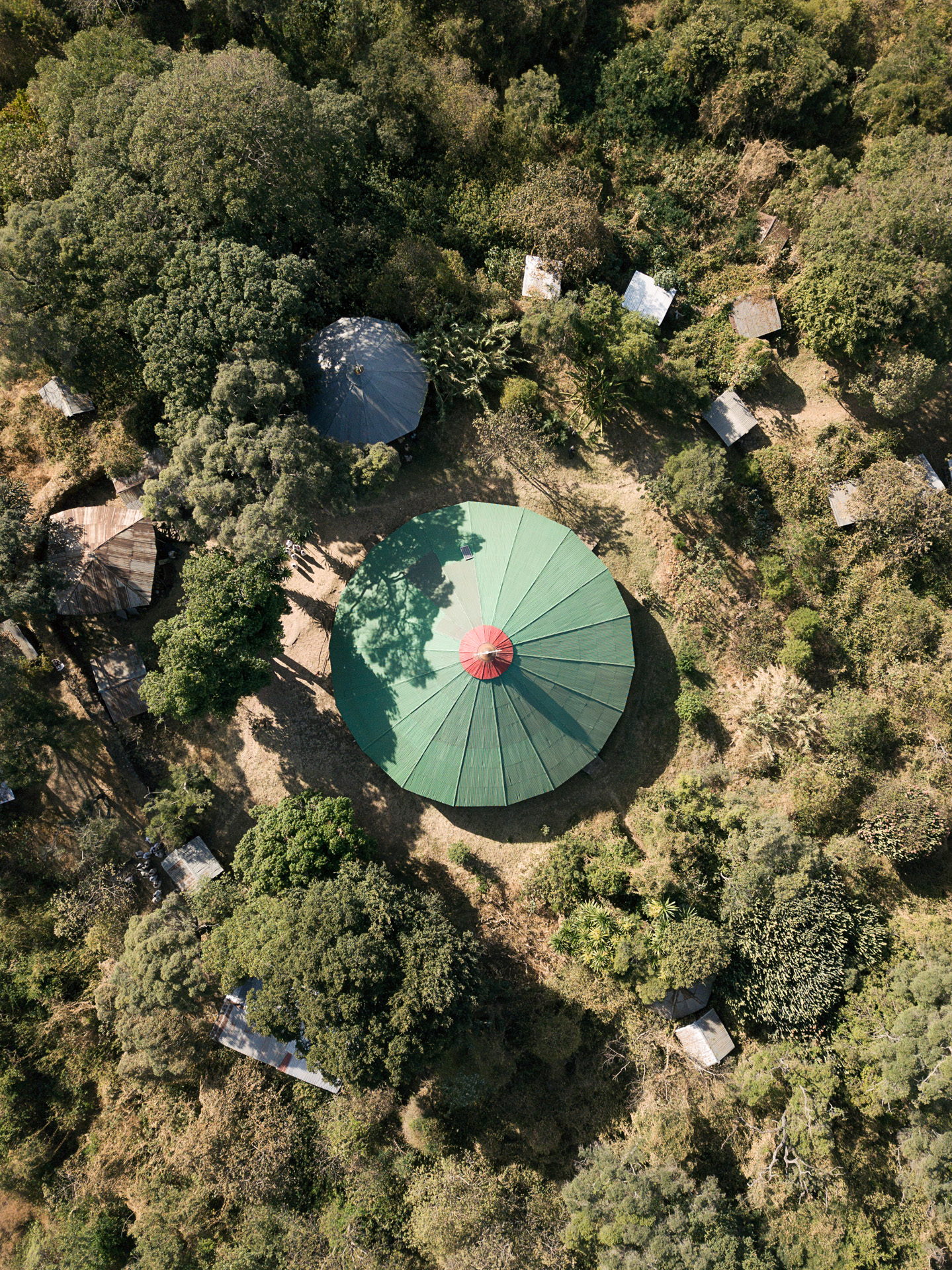
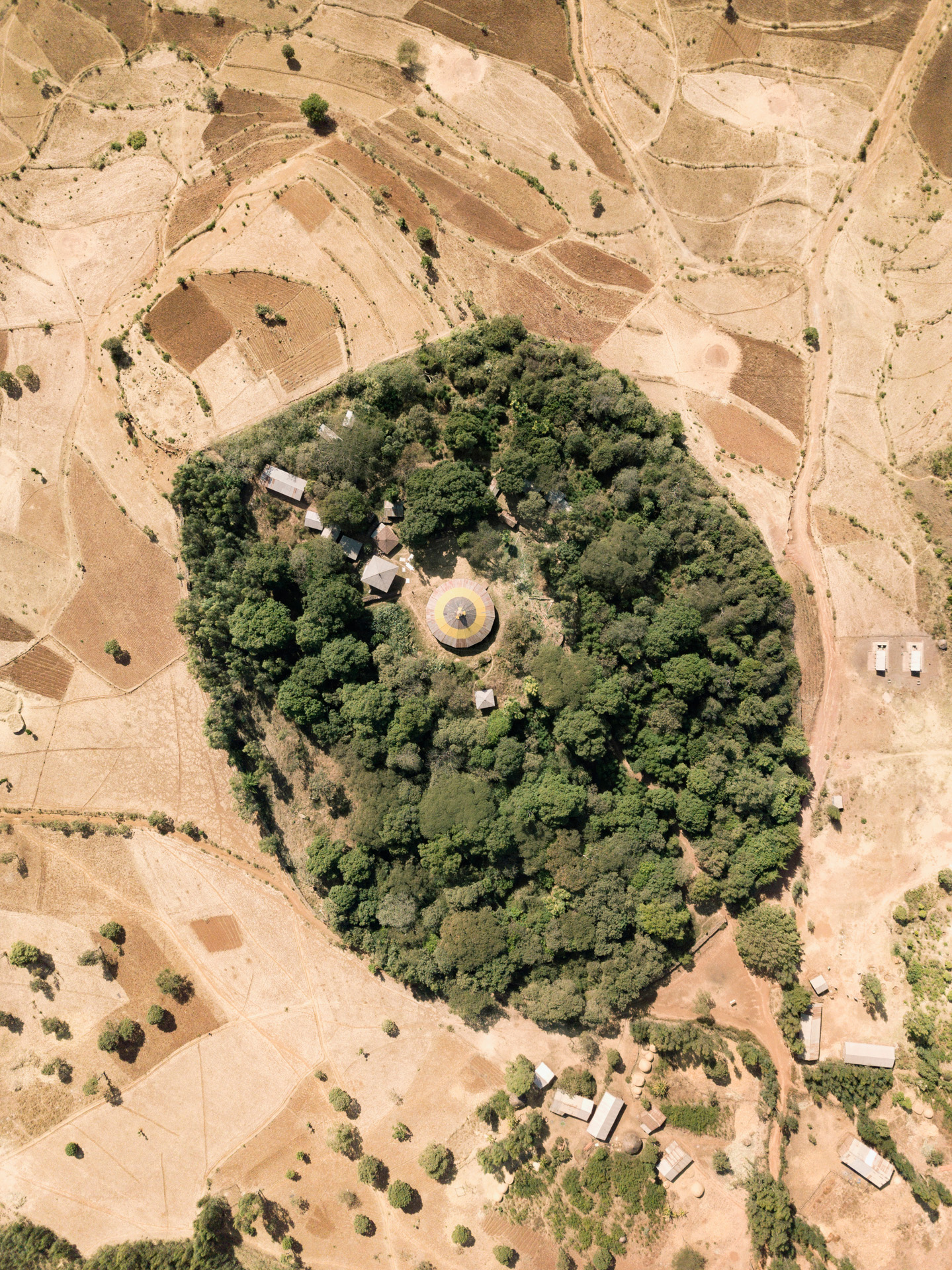
CGH: How did you get to the church forests for the first time, and what was that like?
KD: When I was doing the reading, I found a couple of names kept popping up. One was Dr. Alemayehu Wassie Eshete, and another was Dr. Meg Lowman. I reached out to Dr. Lowman, and she said, “Come out sometime.” Then I managed to get some funding from the Royal Photographic Society, and in January 2016, I flew out to Ethiopia. I went up to Bahir Dar and Lake Tana, and met with Dr. Lowman and Dr. Eshete, and they introduced me to the forests.
The thing that struck me the most was the moment—going from Scotland in January, where it's dark and cold, to suddenly being in the very hot, parched landscape of Ethiopia, melting under the heat—to then passing through the gate into a cool, fragrant, noise-filled forest. It was like crossing into another dimension.
That's really what I was trying to convey in the photographs, that feeling of the difference between the two spheres.
![]()
KD: When I was doing the reading, I found a couple of names kept popping up. One was Dr. Alemayehu Wassie Eshete, and another was Dr. Meg Lowman. I reached out to Dr. Lowman, and she said, “Come out sometime.” Then I managed to get some funding from the Royal Photographic Society, and in January 2016, I flew out to Ethiopia. I went up to Bahir Dar and Lake Tana, and met with Dr. Lowman and Dr. Eshete, and they introduced me to the forests.
The thing that struck me the most was the moment—going from Scotland in January, where it's dark and cold, to suddenly being in the very hot, parched landscape of Ethiopia, melting under the heat—to then passing through the gate into a cool, fragrant, noise-filled forest. It was like crossing into another dimension.
That's really what I was trying to convey in the photographs, that feeling of the difference between the two spheres.

CGH: How long did you spend in Ethiopia?
KD: My first trip in January 2016 lasted five weeks. The idea was to approach the project like the Book of Genesis, in which there are two twin lenses. When you see a picture of a forest from above, most people perceive that as the “God’s-eye view.” But in Genesis, there are two “God’s-eye views.” One is the aerial view. But the other is on the ground, where He’s walking the garden in the cool of the day.
So my goal for the first trip was to capture that second aspect of Genesis: to walk in the garden and be down there with the people. And so I did that for five weeks: getting access, getting around, getting to know the place. Then the next trip, in 2018, was to get the aerials. That was a shorter trip, just under two weeks.
CGH: What was the most surprising thing you encountered while doing this project?
KD: The fact that the Ethiopian Christians see it as a tenet of their faith to protect these forests. With the caveat that, before Dr. Eshete and other scientists began holding educational workshops for the Orthodox priests, the people didn’t know the forests were disappearing. They were taking care of the forests naturally, but they didn’t know they needed intentional protection.
But when they learned from the scientists what was happening, the response was not, “Alright, stop lecturing,” or, “Fine, we'll do it,” which is the response I’m used to seeing. At these workshops, the priests would run out the door to go tell everyone. In fact, the first wall built to protect a church forest was just the local priests and villagers spontaneously gathering rocks and piling them up, because they were so motivated. They realized they were letting the forest down.
That kind of response was such a surprise and a delight to me. The church forests are part of the whole theological system for the Ethiopian Orthodox Church, but in the normal day-to-day life, you just try to survive. You try to look after your kids. And the slow things are forgotten. But for them, they were saying, actually that slow thing, we need to remember that, otherwise it becomes a quite urgent thing. And what a powerful belief, to be lying latent inside of people.
KD: My first trip in January 2016 lasted five weeks. The idea was to approach the project like the Book of Genesis, in which there are two twin lenses. When you see a picture of a forest from above, most people perceive that as the “God’s-eye view.” But in Genesis, there are two “God’s-eye views.” One is the aerial view. But the other is on the ground, where He’s walking the garden in the cool of the day.
So my goal for the first trip was to capture that second aspect of Genesis: to walk in the garden and be down there with the people. And so I did that for five weeks: getting access, getting around, getting to know the place. Then the next trip, in 2018, was to get the aerials. That was a shorter trip, just under two weeks.
CGH: What was the most surprising thing you encountered while doing this project?
KD: The fact that the Ethiopian Christians see it as a tenet of their faith to protect these forests. With the caveat that, before Dr. Eshete and other scientists began holding educational workshops for the Orthodox priests, the people didn’t know the forests were disappearing. They were taking care of the forests naturally, but they didn’t know they needed intentional protection.
But when they learned from the scientists what was happening, the response was not, “Alright, stop lecturing,” or, “Fine, we'll do it,” which is the response I’m used to seeing. At these workshops, the priests would run out the door to go tell everyone. In fact, the first wall built to protect a church forest was just the local priests and villagers spontaneously gathering rocks and piling them up, because they were so motivated. They realized they were letting the forest down.
That kind of response was such a surprise and a delight to me. The church forests are part of the whole theological system for the Ethiopian Orthodox Church, but in the normal day-to-day life, you just try to survive. You try to look after your kids. And the slow things are forgotten. But for them, they were saying, actually that slow thing, we need to remember that, otherwise it becomes a quite urgent thing. And what a powerful belief, to be lying latent inside of people.
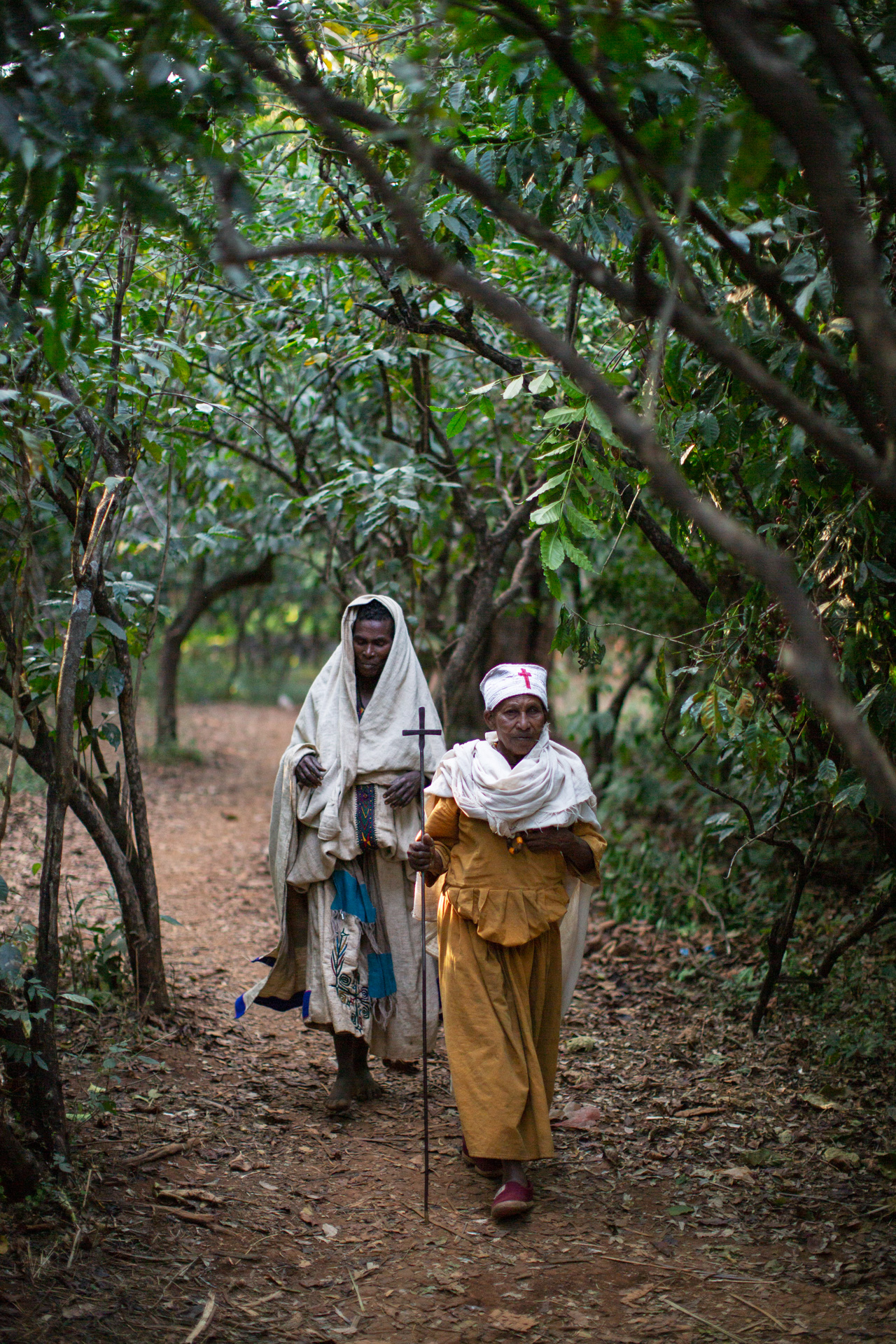
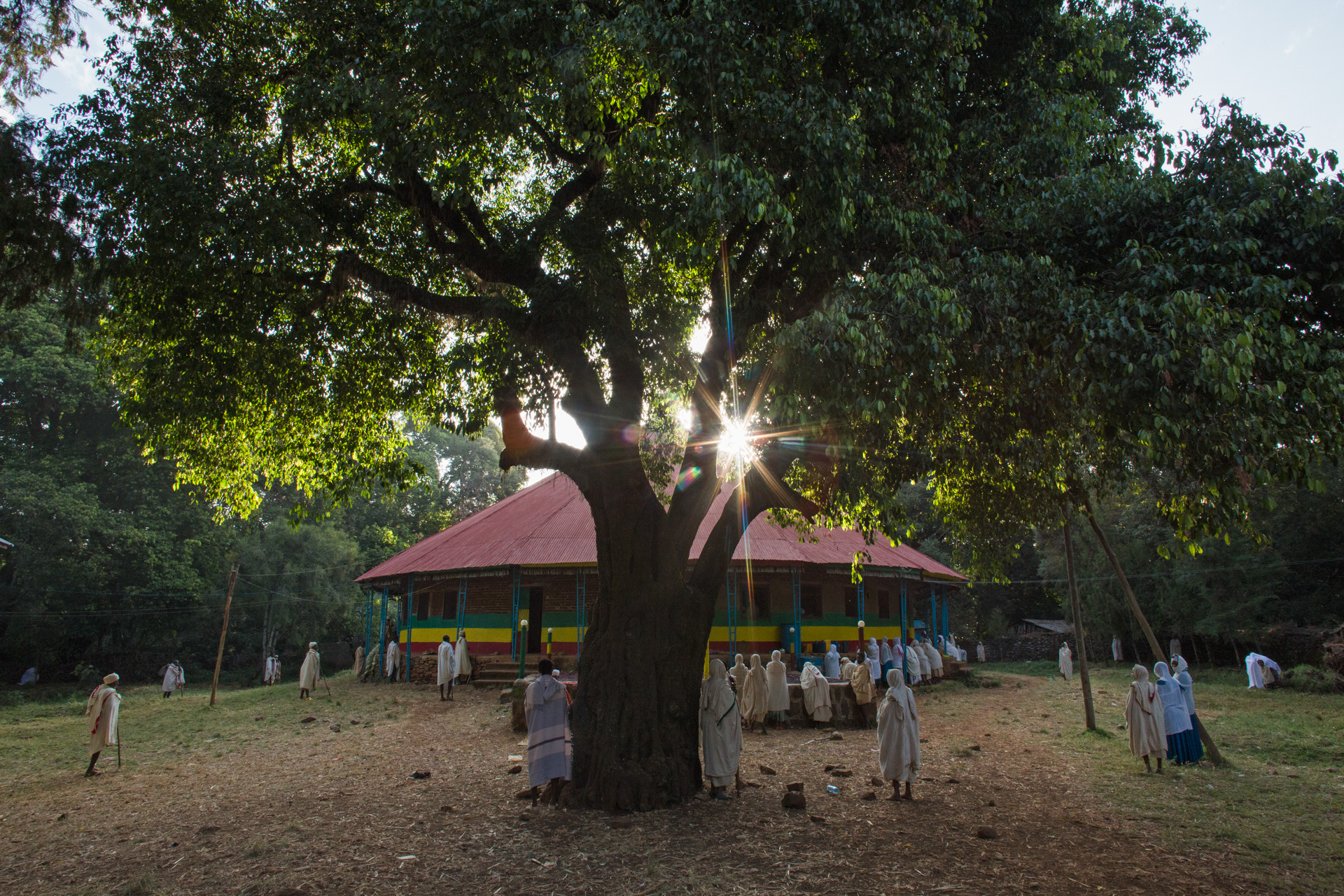
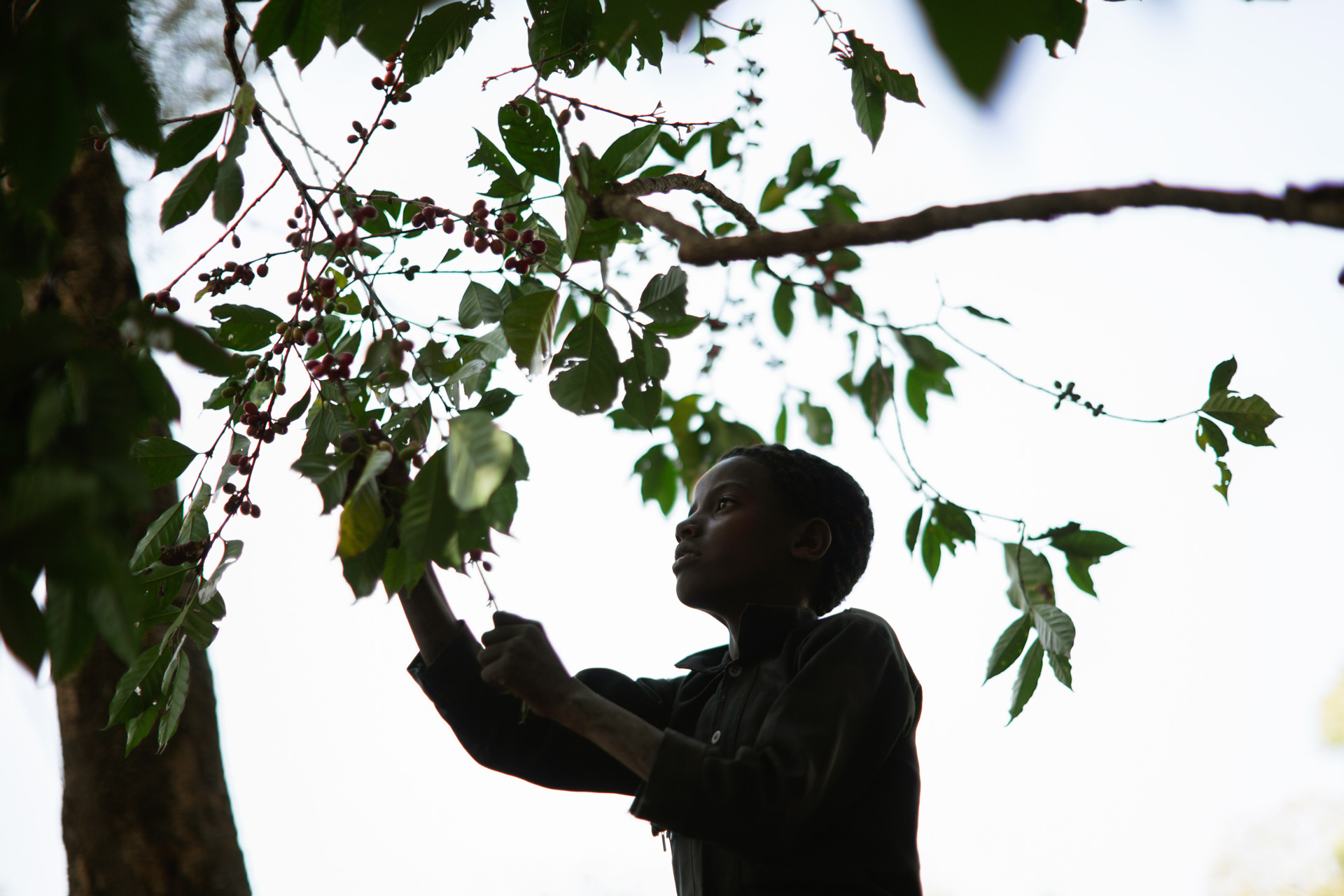
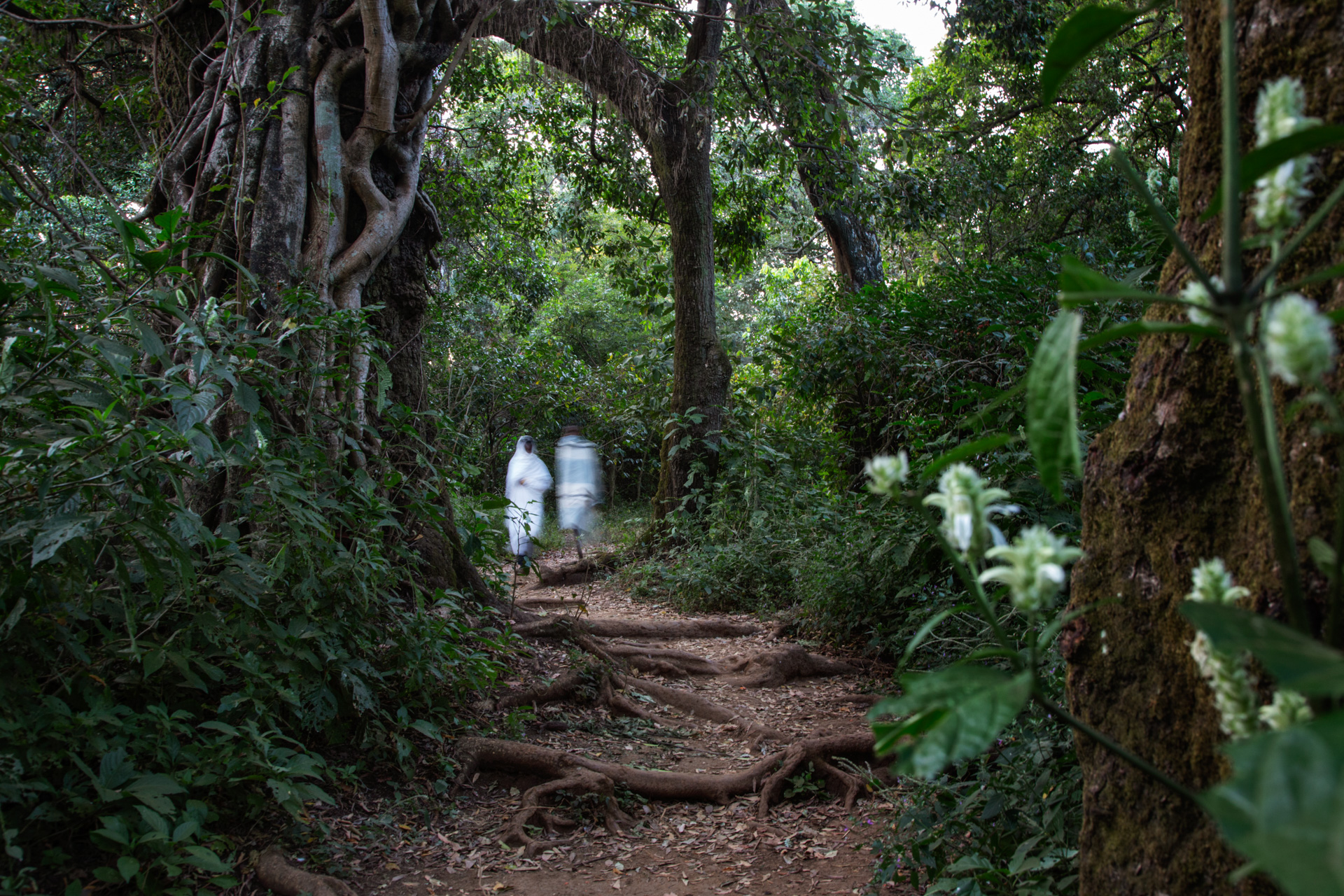
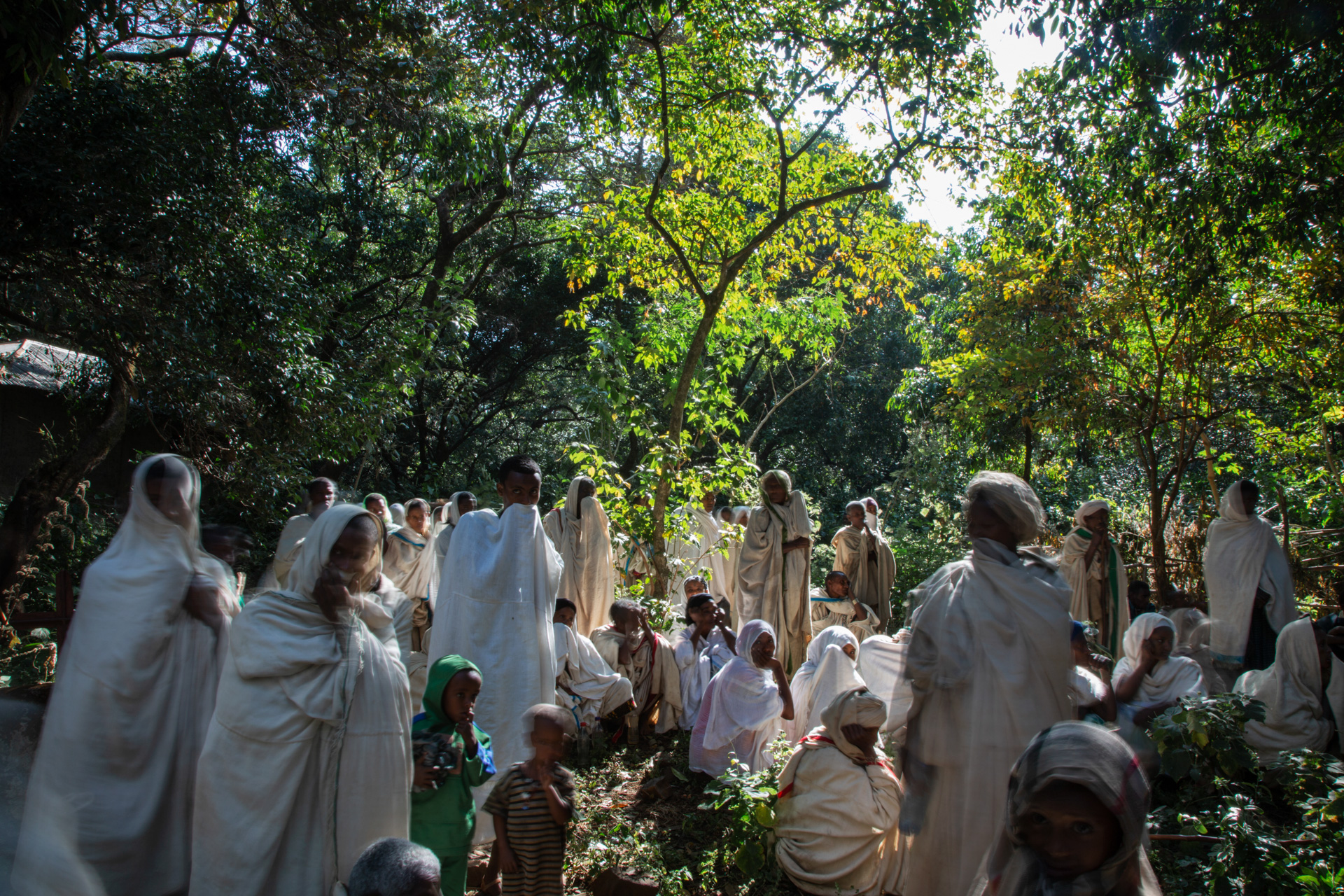
CGH: Are these forests only in a certain part of Ethiopia, or are they all over the country?
KD: They're predominantly in the north, around Lake Tana. If you zoom in on Google Maps to Lake Tana, the biggest body of water in Ethiopia, you'll start these little dots appearing. Those are the forests, and there are over 11,000 of them in the Amhara region.
CGH: Do you know why they happened to be congregated there? Why aren’t they in more places?
KD: Well, the North is historically where the Christians have been. In the South, there are a lot of other tribes with more animistic beliefs, and there are also areas of Islamic influence, like Harar sometimes called the fourth city of Islam. And some parts of Ethiopia are just arid desert.
CGH: Wow, I didn’t realize the difference was so stark. And in the photos, you can see the forests surrounded by this pale brown, dry-looking land. What is that land? Is it farmland?
KD: Yeah, that’s farmland. The photos were taken in the dry season. In the wet season and afterwards, that brown land will green up with crops. It’s a very light green, though, and there’s still quite a difference between that and the deep dark green of the forests. So in the photographs, I'm using the most “extreme” view, to accentuate the difference between what is transient and what is permanent—and also to make the point that if it isn't kept, it will desertify. The Sahara, the Sahel region, which is very dry, is not that far from there. So you can imagine it swooping down.
KD: They're predominantly in the north, around Lake Tana. If you zoom in on Google Maps to Lake Tana, the biggest body of water in Ethiopia, you'll start these little dots appearing. Those are the forests, and there are over 11,000 of them in the Amhara region.
CGH: Do you know why they happened to be congregated there? Why aren’t they in more places?
KD: Well, the North is historically where the Christians have been. In the South, there are a lot of other tribes with more animistic beliefs, and there are also areas of Islamic influence, like Harar sometimes called the fourth city of Islam. And some parts of Ethiopia are just arid desert.
CGH: Wow, I didn’t realize the difference was so stark. And in the photos, you can see the forests surrounded by this pale brown, dry-looking land. What is that land? Is it farmland?
KD: Yeah, that’s farmland. The photos were taken in the dry season. In the wet season and afterwards, that brown land will green up with crops. It’s a very light green, though, and there’s still quite a difference between that and the deep dark green of the forests. So in the photographs, I'm using the most “extreme” view, to accentuate the difference between what is transient and what is permanent—and also to make the point that if it isn't kept, it will desertify. The Sahara, the Sahel region, which is very dry, is not that far from there. So you can imagine it swooping down.
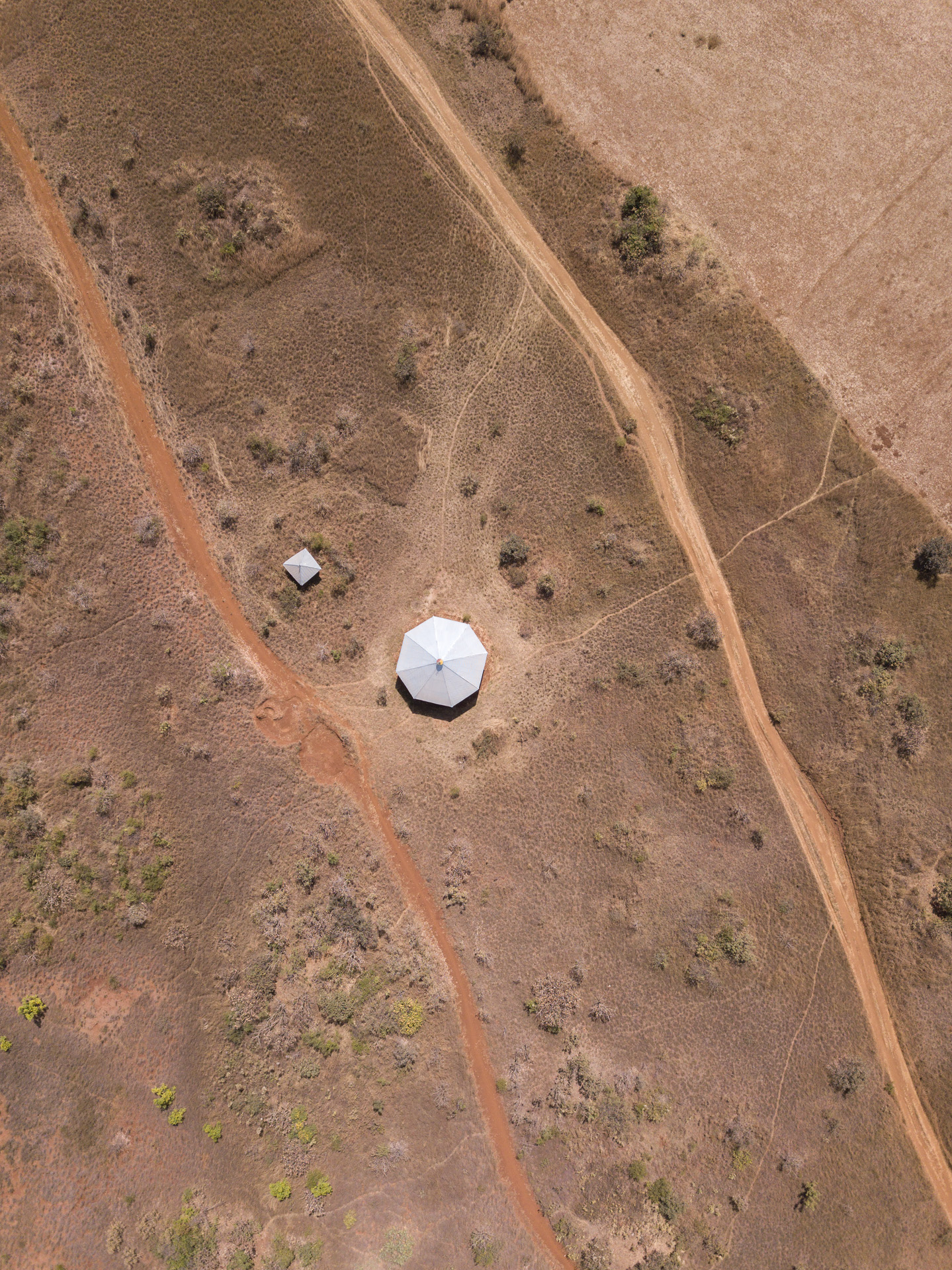
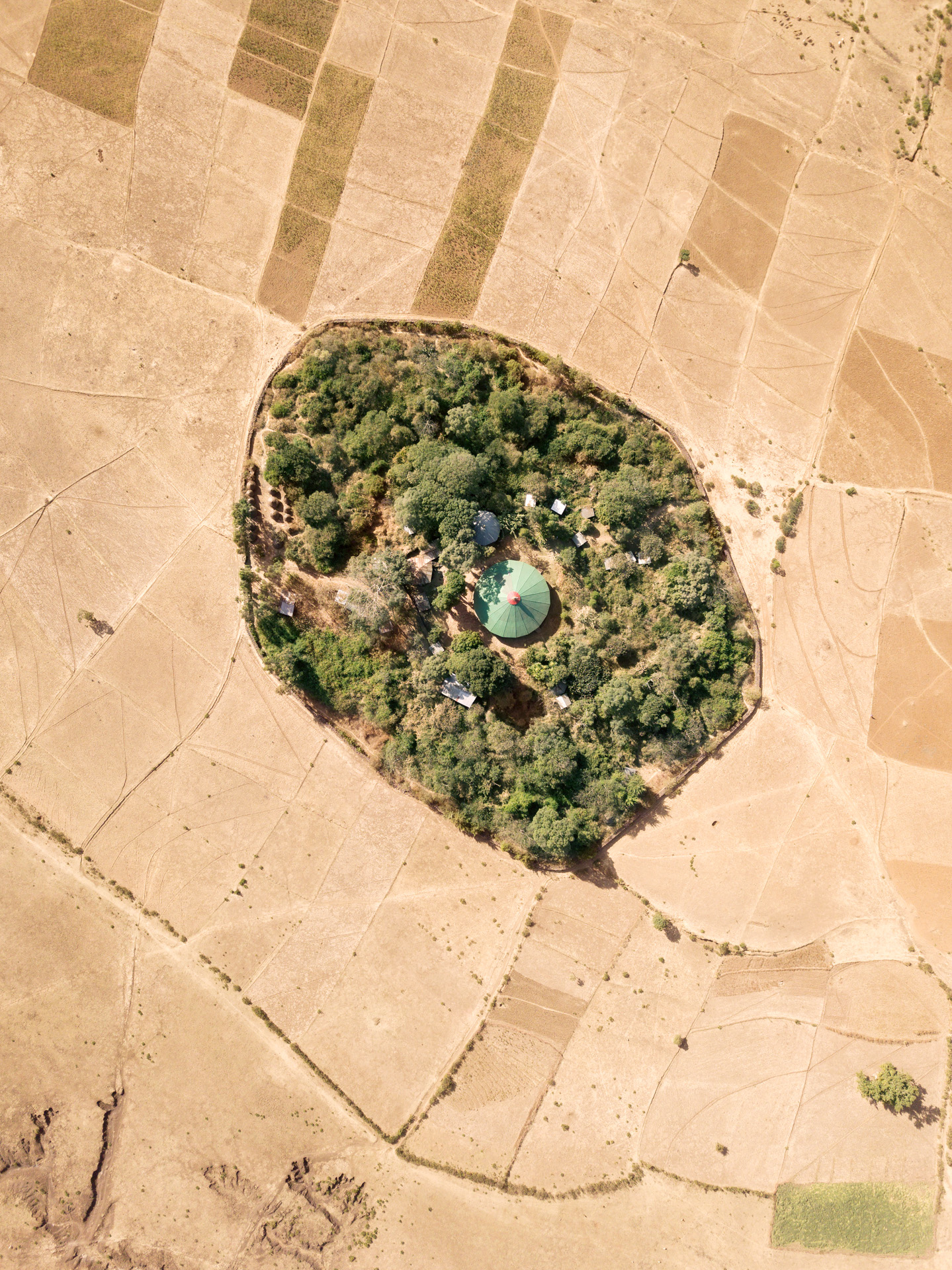
CGH: What is the relationship between the church forests and the local or national governments? Is there institutional support for them?
KD: There’s no official protection just now. The Orthodox Church will now at national level say, you know, “Look after your forests,” but that's quite a recent thing, and it’s partly, I think, because of the work of people like Dr. Eshete and Dr. Lowman.
One thing in the book I talk about is the Great Green Wall, which is an international ambition to build a connecting forest from The Gambia over to Somalia underneath the Sahara—just plant it up with trees to stop the desert from going too far south.
So you’ve got this incredible idea, the Great Green Wall of Africa. And if you look at it, it actually comes down pretty much to where the church forests are, before looping off to the East. Yet, there's no link-up between this huge supranatural ambition and the local communities’ supernatural ambitions. They’ve not joined the dots between those things. And I wonder sometimes whether that’s not necessarily a bad thing, because I think the strength of the church forests is that they’ve always been a local community effort. The people there are going to look after the forests because they see the value of them, personally. If the government comes in and tells you what to do, it's a different mindset, isn’t it?
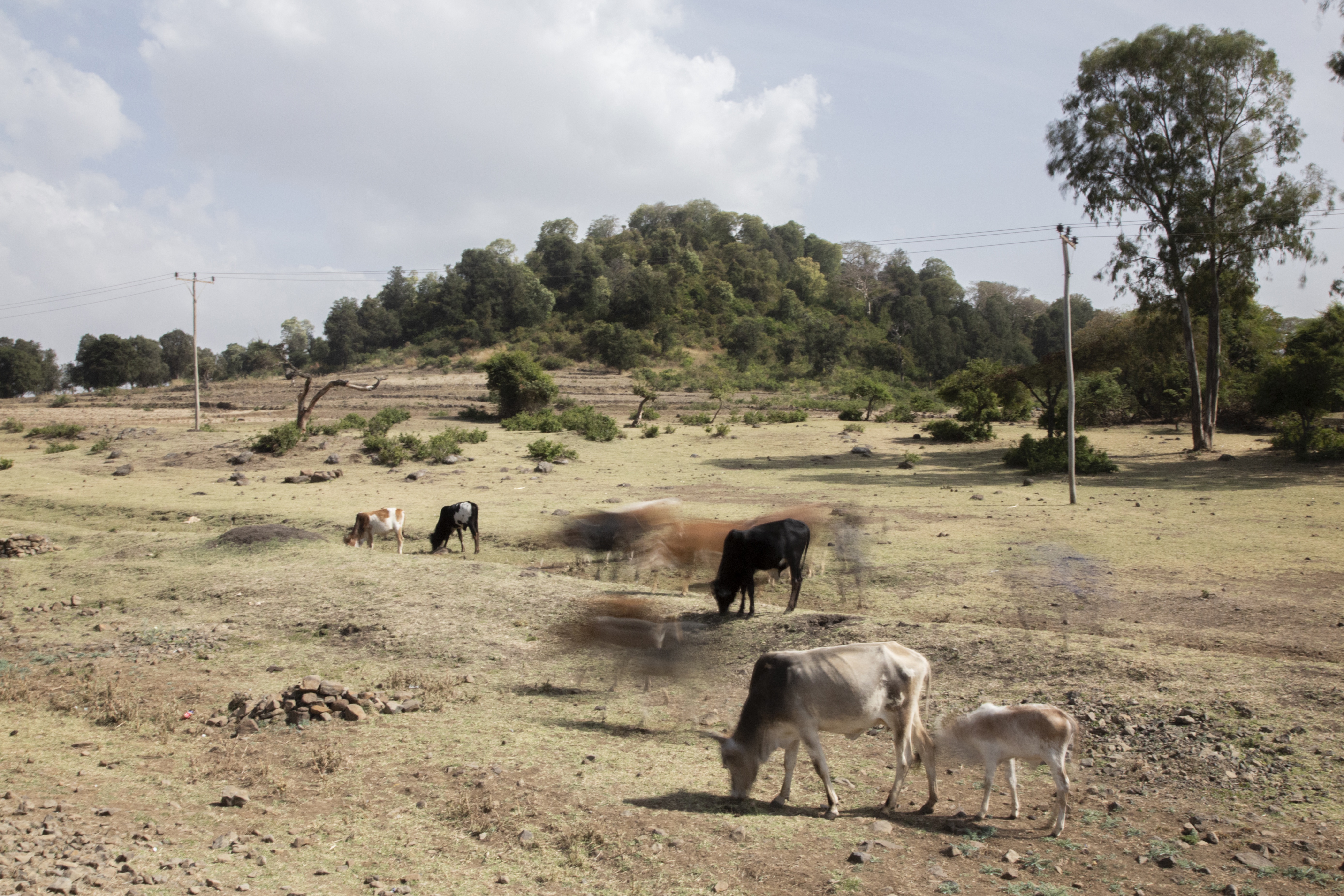
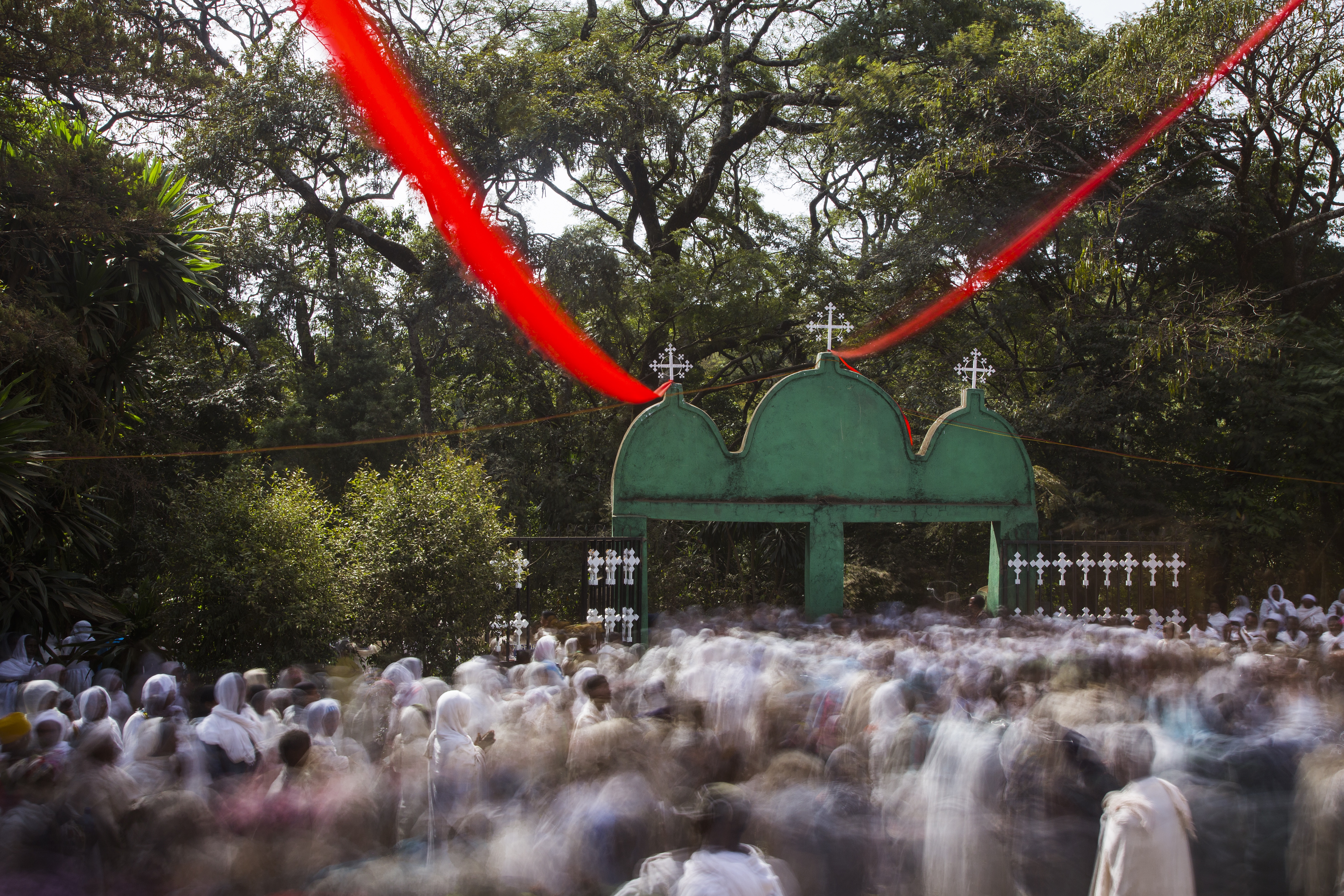

CGH: Where does the idea of the church building needing an accompanying forest come from? Does it come from Scripture?
KD: It comes from Genesis. The forests are like little gardens of Eden. The idea is, Eden has trees, so should the church. As man was in Eden, and God was there and it was good, so when God is in his church, we must surround it with nature. When you speak to the priests, that is what they are drawing on when they talk about protecting the church forests.
This kind of value for nature goes back centuries. You can see it in the artwork. Some of the churches I visited are medieval, and the paintings on their walls are of biblical stories, political warriors and kings, or martyrs. But between all these little visual stories—they’re incredible, they’re like illuminated gospels—are these beautiful vines and trees. The whole story of the Ethiopian Orthodox faith is enriched with this natural visual language. Then, when you read the liturgy, there are these anaphora, which are like a song call and response prayers or song, that also feature nature heavily. I included a few of them in the book.
KD: It comes from Genesis. The forests are like little gardens of Eden. The idea is, Eden has trees, so should the church. As man was in Eden, and God was there and it was good, so when God is in his church, we must surround it with nature. When you speak to the priests, that is what they are drawing on when they talk about protecting the church forests.
This kind of value for nature goes back centuries. You can see it in the artwork. Some of the churches I visited are medieval, and the paintings on their walls are of biblical stories, political warriors and kings, or martyrs. But between all these little visual stories—they’re incredible, they’re like illuminated gospels—are these beautiful vines and trees. The whole story of the Ethiopian Orthodox faith is enriched with this natural visual language. Then, when you read the liturgy, there are these anaphora, which are like a song call and response prayers or song, that also feature nature heavily. I included a few of them in the book.
This is the anaphora of St. Basil:
Holy, holy, holy art Thou
Lord, our God and our creator
who puts us in the garden of delight.
And when we committed an iniquity
And transgressed through the guile of the serpent,
we fell far from eternal life
And were cast out of the Garden of delight.
That kind of thing is being said every Sunday. It is part of the warp and the woof of the liturgy.
My favorite one is the anaphora of St. Cyril:
My favorite one is the anaphora of St. Cyril:
A weak tree carried him who carries heaven and earth
A narrow grave contained him
Before whom heaven and Earth tremble
When he was buried in it
A weak tree carried him who carries heaven and earth

CGH: Wow. Beautiful. How did they come to interpret Genesis in this way? I haven't heard of any other denominations or sects who believe forests are key to church buildings. Do you know how this theology developed?
KD: The Ethiopian Orthodox Church, from what I understand, is very influenced by Old Testament imagery in general. For example, the church building itself is built in the form of the Temple or tabernacle. It’s circular, and within it you’ve got the Holy Place, and in the center, the square Most Holy Place. And in the center of each church building is a Tabot which is a copy of the Law of the Covenant. It’s got this very Old Testament idea. So I suppose it fits more naturally for the forest and Eden to be in the imagery. It’s working as an icon. And that's why I called the project Hierotopia originally. It’s Alexei Lidov’s hierotopy idea of objects, like paintings and clothes and architecture, telling people who they were dealing with.
![]()
CGH: I would love to talk to a church scholar at some point and hear more about how different churches and denominations and sects have interpreted the scriptures to shape their buildings, to the things that they do during the services, the liturgy, the icons, the art—because it's so foreign to evangelical American churches. We’re different.
KD: Well, the prompt you sent me discusses the idea of an agrarian society unable to understand how much it actually depends on the land. Most Westerners are post-agricultural now, we're urban dwellers. It’s hard for us to understand that when we turn the tap on, the water comes from somewhere. We find it hard to understand, when we’re sitting outside on our plastic lawns surrounded by breeze blocks under the sun, enjoying the TV, that the water in the pool came from somewhere, and we owe a debt to the environment for that.
Whereas in this area of Ethiopia, people are going outside the forest straight to their farms. They’re growing their food there. It’s much easier to see the connection between your own life and the forest when you can see pollinators flying from the forest onto your crops and flying back again and making honey.
![]()
KD: The Ethiopian Orthodox Church, from what I understand, is very influenced by Old Testament imagery in general. For example, the church building itself is built in the form of the Temple or tabernacle. It’s circular, and within it you’ve got the Holy Place, and in the center, the square Most Holy Place. And in the center of each church building is a Tabot which is a copy of the Law of the Covenant. It’s got this very Old Testament idea. So I suppose it fits more naturally for the forest and Eden to be in the imagery. It’s working as an icon. And that's why I called the project Hierotopia originally. It’s Alexei Lidov’s hierotopy idea of objects, like paintings and clothes and architecture, telling people who they were dealing with.
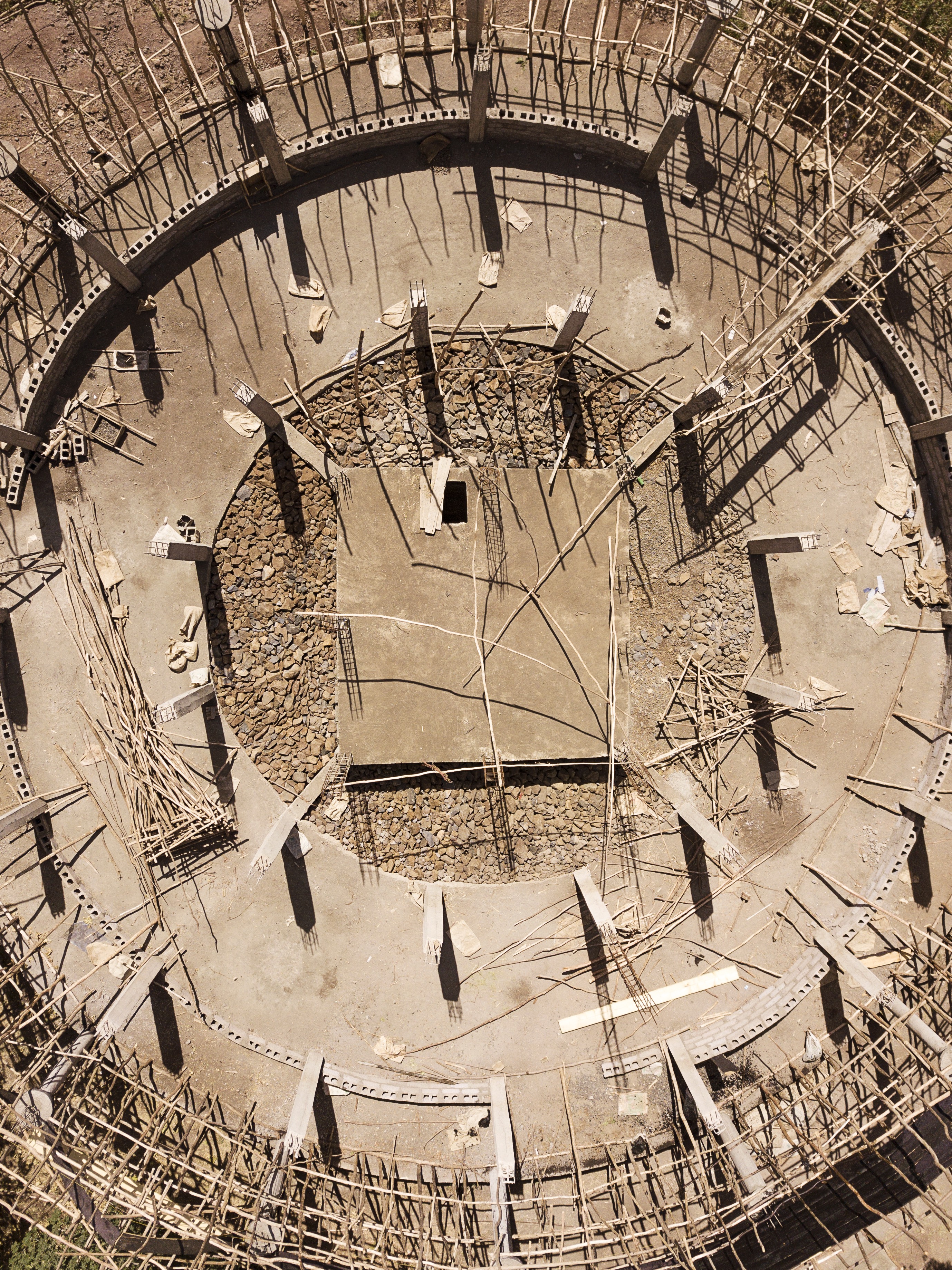
CGH: I would love to talk to a church scholar at some point and hear more about how different churches and denominations and sects have interpreted the scriptures to shape their buildings, to the things that they do during the services, the liturgy, the icons, the art—because it's so foreign to evangelical American churches. We’re different.
KD: Well, the prompt you sent me discusses the idea of an agrarian society unable to understand how much it actually depends on the land. Most Westerners are post-agricultural now, we're urban dwellers. It’s hard for us to understand that when we turn the tap on, the water comes from somewhere. We find it hard to understand, when we’re sitting outside on our plastic lawns surrounded by breeze blocks under the sun, enjoying the TV, that the water in the pool came from somewhere, and we owe a debt to the environment for that.
Whereas in this area of Ethiopia, people are going outside the forest straight to their farms. They’re growing their food there. It’s much easier to see the connection between your own life and the forest when you can see pollinators flying from the forest onto your crops and flying back again and making honey.
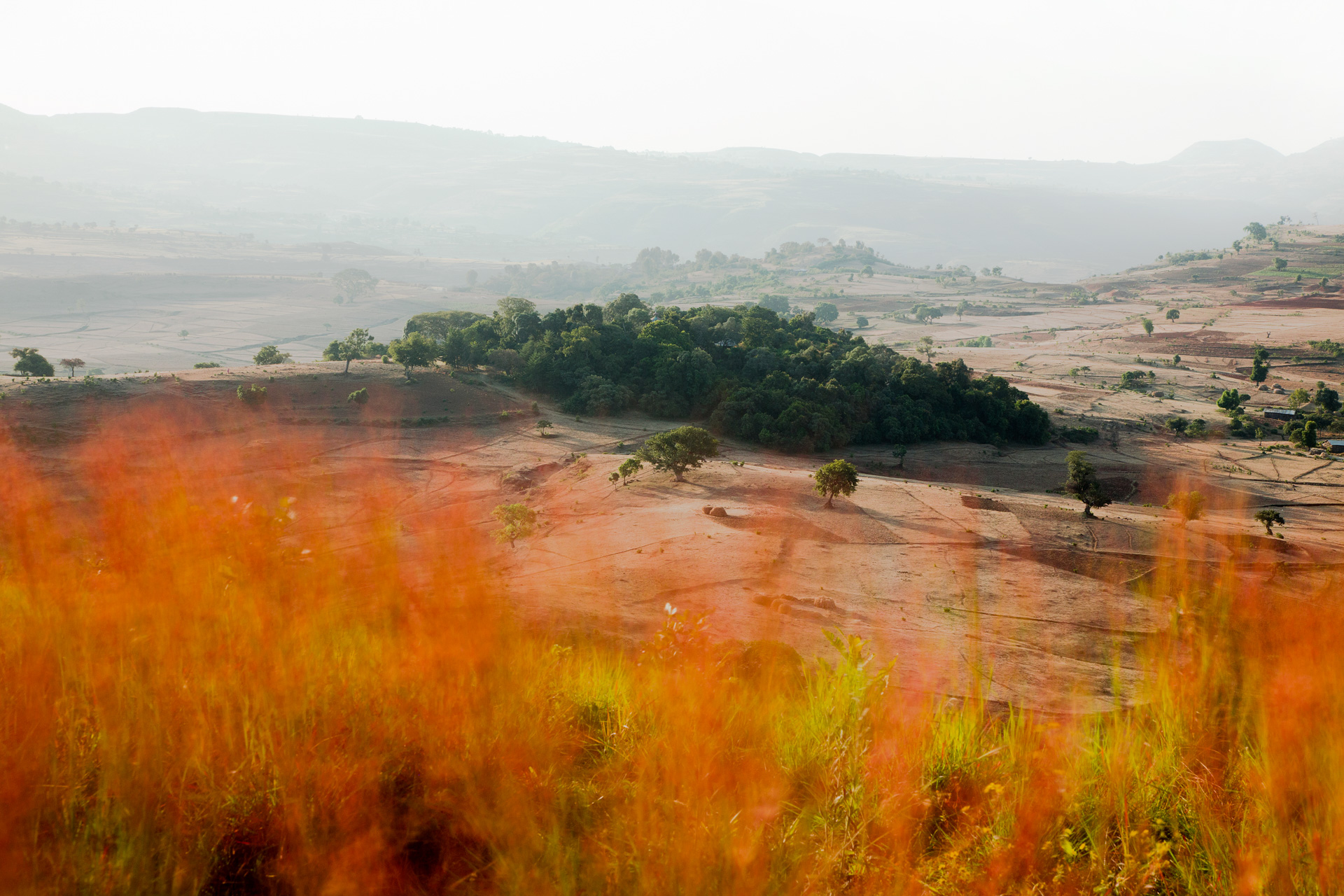
CGH: Here in the U.S., Christians kind of have a reputation for being anti-environmentalist. There's a skepticism about it. A skepticism, for example, that climate change exists. Is it the same way in Scotland?
KD: The churches I’d be part of wouldn’t be openly saying, “Let’s go protect the environment,” but I never felt discouraged from what I did, and in fact, I’ve always experienced people seeing the value of it.
For the book, I commissioned an essay from an environmental historian, Mark Stoll. He writes about how Puritan religion is at the root of modern environmentalism. If you look back to Scottish theological scholars from that time, it’s there, and Calvin speaks about it—these reformed theologians whom the Evangelical Church in America would draw upon—it’s in Calvin, it’s in Augustine. But there’s almost now a blind spot to it.
But the environmental movement was founded on Christian ideas. They still use terms from a Christian worldview, like, “We've got to care for our neighbor.” And Greta Thunberg is a lot like a Puritan preacher, the way she speaks and the way she calls this a moral crusade. So there’s a Christian framework, but it is often lacking hope and grace. There’s a sense of carbon as sin, as your guilt, and you’ve got to somehow, by your effort, get rid of your footprint. But that can be a disempowering framework for many people, because it’s such a global problem. And you start to feel the weight of the world’s carbon on your shoulders, and feel like you’ve got to somehow divest it from yourself. I think there’s a better story that Christians can help tell.
CGH: The essay on your website says, “In theory, the core of Christian belief in stewardship for the environment is a powerful concept. And if applied globally by people who are at least nominally Christian, could transform the world for the better.” What does that look like to you?
KD: It’ll be different in different contexts, I suppose. But the Ethiopian Church, of course, would be a good example. That’s maybe why I’ve spent so much time on this project and made a book about it. The Ethiopian Christians aren’t campaigning for climate justice in the streets, they aren’t doing anything self-consciously so that outsiders will look and go, “Wow, these guys are really protecting the environment.” They're just getting on with being Christians. Their priority is to know God, to live for God, and protecting the forests has flowed from that.
And I suppose the question is, how would that look for you, in Northern California? How does it look for me in Scotland? If God has made the world and he cares about it, that should fire us up to want to look after it. It might be different from the way the world does climate justice. We don’t necessarily have to march and shout and sing. Maybe it’s just people quietly getting on with day-to-day life, protecting a tree or coppicing a hedge, and looking after and tending and gathering over the seasons.
I covered the COP Summit (United Nations Climate Change Conference) in Glasgow this past October, and at one of the marches, I kept hearing the refrain: “What do we want?” “Climate justice!” “When do we want it?” “Now!” Whereas the Christian value of patience says, “We want it urgently, but we need to build a longer-term approach.”
I did a story on rewilding in Scotland, at an estate in Cairngorms National Park called Glen Feshie. And I asked the main conservationist there, “What’s your plan for this valley? I know you’re trying to rewild it.” And he said to me, without knowing any of my background, “We’re doing cathedral thinking. We have a long-term vision, a 200-year plan.”
I think that’s the difference a Christian should have. Cathedral thinking, a long-term vision. To not be scared to think 200 years into the future, when our own lives are over.
KD: The churches I’d be part of wouldn’t be openly saying, “Let’s go protect the environment,” but I never felt discouraged from what I did, and in fact, I’ve always experienced people seeing the value of it.
For the book, I commissioned an essay from an environmental historian, Mark Stoll. He writes about how Puritan religion is at the root of modern environmentalism. If you look back to Scottish theological scholars from that time, it’s there, and Calvin speaks about it—these reformed theologians whom the Evangelical Church in America would draw upon—it’s in Calvin, it’s in Augustine. But there’s almost now a blind spot to it.
But the environmental movement was founded on Christian ideas. They still use terms from a Christian worldview, like, “We've got to care for our neighbor.” And Greta Thunberg is a lot like a Puritan preacher, the way she speaks and the way she calls this a moral crusade. So there’s a Christian framework, but it is often lacking hope and grace. There’s a sense of carbon as sin, as your guilt, and you’ve got to somehow, by your effort, get rid of your footprint. But that can be a disempowering framework for many people, because it’s such a global problem. And you start to feel the weight of the world’s carbon on your shoulders, and feel like you’ve got to somehow divest it from yourself. I think there’s a better story that Christians can help tell.
CGH: The essay on your website says, “In theory, the core of Christian belief in stewardship for the environment is a powerful concept. And if applied globally by people who are at least nominally Christian, could transform the world for the better.” What does that look like to you?
KD: It’ll be different in different contexts, I suppose. But the Ethiopian Church, of course, would be a good example. That’s maybe why I’ve spent so much time on this project and made a book about it. The Ethiopian Christians aren’t campaigning for climate justice in the streets, they aren’t doing anything self-consciously so that outsiders will look and go, “Wow, these guys are really protecting the environment.” They're just getting on with being Christians. Their priority is to know God, to live for God, and protecting the forests has flowed from that.
And I suppose the question is, how would that look for you, in Northern California? How does it look for me in Scotland? If God has made the world and he cares about it, that should fire us up to want to look after it. It might be different from the way the world does climate justice. We don’t necessarily have to march and shout and sing. Maybe it’s just people quietly getting on with day-to-day life, protecting a tree or coppicing a hedge, and looking after and tending and gathering over the seasons.
I covered the COP Summit (United Nations Climate Change Conference) in Glasgow this past October, and at one of the marches, I kept hearing the refrain: “What do we want?” “Climate justice!” “When do we want it?” “Now!” Whereas the Christian value of patience says, “We want it urgently, but we need to build a longer-term approach.”
I did a story on rewilding in Scotland, at an estate in Cairngorms National Park called Glen Feshie. And I asked the main conservationist there, “What’s your plan for this valley? I know you’re trying to rewild it.” And he said to me, without knowing any of my background, “We’re doing cathedral thinking. We have a long-term vision, a 200-year plan.”
I think that’s the difference a Christian should have. Cathedral thinking, a long-term vision. To not be scared to think 200 years into the future, when our own lives are over.
 (photo from Rewilding series for NYTIMES)
(photo from Rewilding series for NYTIMES)CGH: Well, if the natural outflow of our lives as believers is that we would care for the Earth, there is a big gap between our theology and our practices right now. I say that for myself as well. Up until a few years ago, I’d never given a thought to, you know, how many plastic water bottles I casually use and throw away. I’ve been inculcated with the idea that life should be convenient, I should have what I want, when I want it. And I used to see that attitude as kind of a spiritually neutral thing, but it's not.
I, for one, would love guidance from pastors, or at least to encounter ecological thinkers and practitioners more regularly in church settings. I think there is a discipleship that needs to happen. We need to be retaught what it means to be embodied creatures, what God desires our relationship with the Earth to be. Otherwise it's all too easy to just slip into the norm of the world, which is to not care—though people may tweet and post about stuff, when it actually comes to living it out, you’re right, it’s much slower and harder. It's much more uncomfortable. But I think that’s where we Christians can distinguish ourselves, you know—by actually laying down our lives. And we have a heritage of fasting, of embracing abnegation of the self. Those are all Christian values.
KD: Even thankfulness. The power of thankfulness. Thank God for an apple and dwell on that for a minute and ask, “Where does this come from? How did I get this?” Sometimes I need to think about that instead, because there’s a lot of eco-guilt I experience, where I just feel terrible, like you said, about the bottles, or like when I’m opening books or paper, I put it in the recycling and I still feel guilty for it. But actually, it’s thankfulness that shapes so much of the Christian life. That's what grace leads us to: to be thankful for everything we’ve been given as a gift. If we don't receive these things with thankfulness, they become bitter.
![]()
CGH: One of the reasons I wanted to have this discussion with you is that you’re not someone who sits and critiques the environmental movement from the sidelines. You can see the pitfalls in, say, secular climate activism, but you’re still involved in it—you're in the fray. And I think that's what we all need to do. We can't just try to keep our hands clean by not getting involved. We have to get in there and learn, and ask the Lord, “What are you asking of me?”
KD: Yeah, I think that’s it, isn’t it? How do we engage, as individuals? Because it’s a global issue, but it needs to be applied locally. And you’ve got to be realistic about what you can do as a person. Some people would say, “Well, no, you can start a movement,” but we also need the humility to know who we are, and to know we’re dependent on one who holds the whole world and sustains it as well.
I’ve been so helped by the teaching of Reverend John Stott. He was a brilliant writer, and he was also an avid birdwatcher. He wrote a book called The Birds, Our Teachers. And he’d say, “Well, it’s what Jesus commanded us to do. The only hobby that is also a command is, ‘Consider the birds.’” So it’s guys like that—I think the teaching is out there. And he is someone who is robust, who’s got his priorities straight, and can see the expansive, interconnected nature of everything.
![]()
CGH: So my last question for you is, what has the impact of this project been on your life?
KD: It’s been a joy to see these ideas I’ve thought about and struggled with over the years—the tension between development and conservation, the apparent tension between religion and science—come together in one project. The church forests aren’t perfect. The trees are still disappearing. But at least I feel like there’s hope, which is unusual in environmental stories.
And I feel I have a part to play. Often, with stories I’ve covered in the past, the pattern is that it gets published a few times and then it disappears, and you’re onto the next thing. But the joy with this is that I’ve been able to linger on it a while and show it in different places, and it’s resonated with many different types of people.
The connection to spiritual ideas, for me, is what enriches it personally. But also, being able to connect it to audiences that don’t have spiritual backgrounds, for them to still get it—I think it stirs up something deep within us. The echo of Eden is within us, whether we’re Christians or not. I’ve enjoyed that: being able to linger on it.
And again, speaking of lingering—we moved to Edinburgh four years ago and we got a garden, and: “What do we want?” “We want plants and crops grown everywhere!” “When do we want them?” “Now!” Well, you’re never going to get them now. A garden takes time. It really does take a long time. The Garden of Eden should teach us: things are slow. Change is slow. The hard work in life: to grow a family, to grow a community, to grow a farm, to grow a forest, it’s just slow. It takes time, and there are weeds. What I’ve found so helpful about this project is seeing the slow work that people have done over generations in Ethiopia. We don’t know who they are. But they’ve maintained us.
Kieran’s book on the Ethiopian Church Forests, Hierotopia, is available for purchase at https://www.kierandodds.com/shop/.
I, for one, would love guidance from pastors, or at least to encounter ecological thinkers and practitioners more regularly in church settings. I think there is a discipleship that needs to happen. We need to be retaught what it means to be embodied creatures, what God desires our relationship with the Earth to be. Otherwise it's all too easy to just slip into the norm of the world, which is to not care—though people may tweet and post about stuff, when it actually comes to living it out, you’re right, it’s much slower and harder. It's much more uncomfortable. But I think that’s where we Christians can distinguish ourselves, you know—by actually laying down our lives. And we have a heritage of fasting, of embracing abnegation of the self. Those are all Christian values.
KD: Even thankfulness. The power of thankfulness. Thank God for an apple and dwell on that for a minute and ask, “Where does this come from? How did I get this?” Sometimes I need to think about that instead, because there’s a lot of eco-guilt I experience, where I just feel terrible, like you said, about the bottles, or like when I’m opening books or paper, I put it in the recycling and I still feel guilty for it. But actually, it’s thankfulness that shapes so much of the Christian life. That's what grace leads us to: to be thankful for everything we’ve been given as a gift. If we don't receive these things with thankfulness, they become bitter.
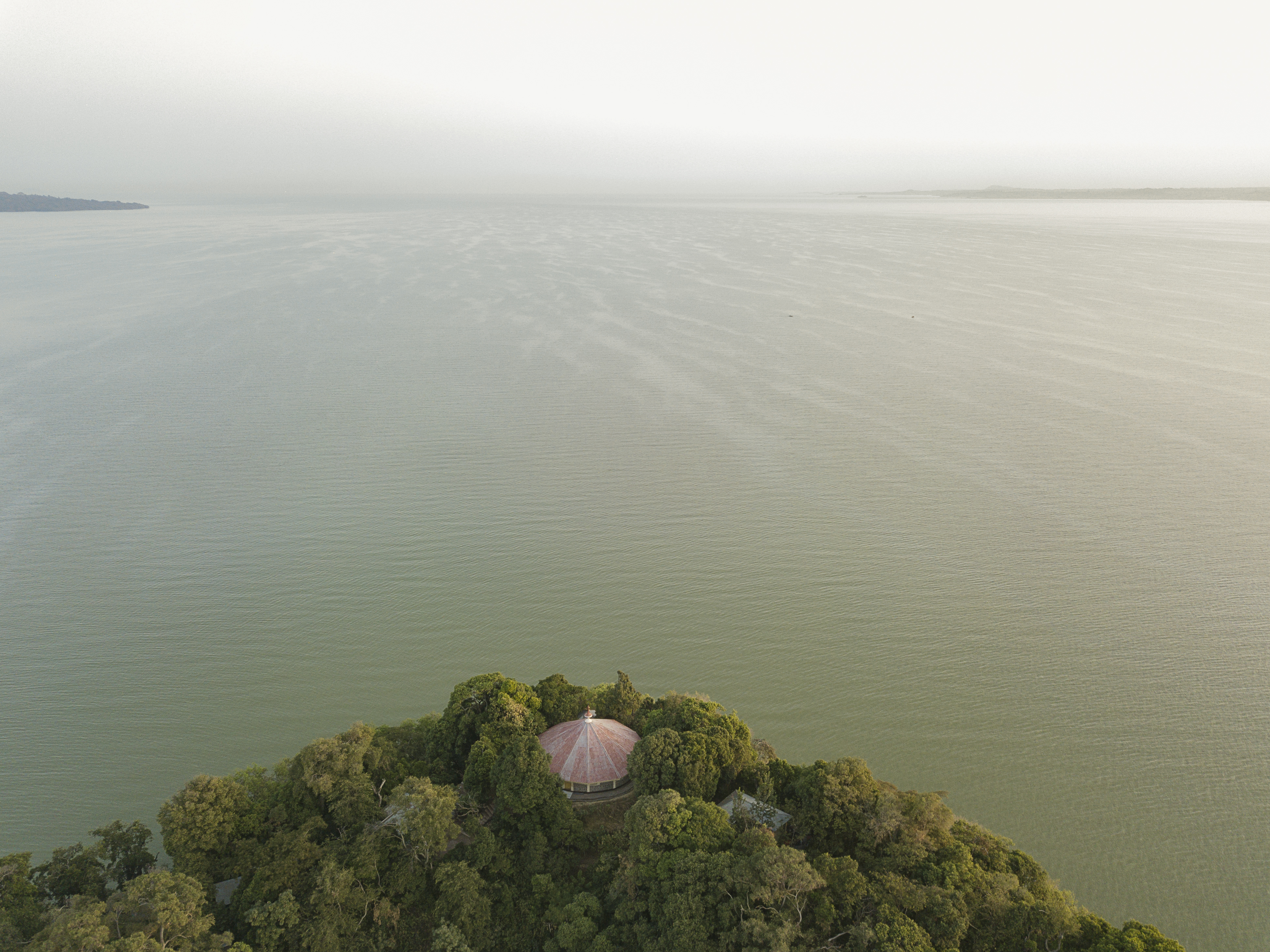
CGH: One of the reasons I wanted to have this discussion with you is that you’re not someone who sits and critiques the environmental movement from the sidelines. You can see the pitfalls in, say, secular climate activism, but you’re still involved in it—you're in the fray. And I think that's what we all need to do. We can't just try to keep our hands clean by not getting involved. We have to get in there and learn, and ask the Lord, “What are you asking of me?”
KD: Yeah, I think that’s it, isn’t it? How do we engage, as individuals? Because it’s a global issue, but it needs to be applied locally. And you’ve got to be realistic about what you can do as a person. Some people would say, “Well, no, you can start a movement,” but we also need the humility to know who we are, and to know we’re dependent on one who holds the whole world and sustains it as well.
I’ve been so helped by the teaching of Reverend John Stott. He was a brilliant writer, and he was also an avid birdwatcher. He wrote a book called The Birds, Our Teachers. And he’d say, “Well, it’s what Jesus commanded us to do. The only hobby that is also a command is, ‘Consider the birds.’” So it’s guys like that—I think the teaching is out there. And he is someone who is robust, who’s got his priorities straight, and can see the expansive, interconnected nature of everything.

CGH: So my last question for you is, what has the impact of this project been on your life?
KD: It’s been a joy to see these ideas I’ve thought about and struggled with over the years—the tension between development and conservation, the apparent tension between religion and science—come together in one project. The church forests aren’t perfect. The trees are still disappearing. But at least I feel like there’s hope, which is unusual in environmental stories.
And I feel I have a part to play. Often, with stories I’ve covered in the past, the pattern is that it gets published a few times and then it disappears, and you’re onto the next thing. But the joy with this is that I’ve been able to linger on it a while and show it in different places, and it’s resonated with many different types of people.
The connection to spiritual ideas, for me, is what enriches it personally. But also, being able to connect it to audiences that don’t have spiritual backgrounds, for them to still get it—I think it stirs up something deep within us. The echo of Eden is within us, whether we’re Christians or not. I’ve enjoyed that: being able to linger on it.
And again, speaking of lingering—we moved to Edinburgh four years ago and we got a garden, and: “What do we want?” “We want plants and crops grown everywhere!” “When do we want them?” “Now!” Well, you’re never going to get them now. A garden takes time. It really does take a long time. The Garden of Eden should teach us: things are slow. Change is slow. The hard work in life: to grow a family, to grow a community, to grow a farm, to grow a forest, it’s just slow. It takes time, and there are weeds. What I’ve found so helpful about this project is seeing the slow work that people have done over generations in Ethiopia. We don’t know who they are. But they’ve maintained us.
Kieran’s book on the Ethiopian Church Forests, Hierotopia, is available for purchase at https://www.kierandodds.com/shop/.